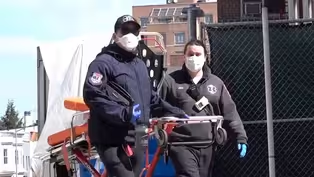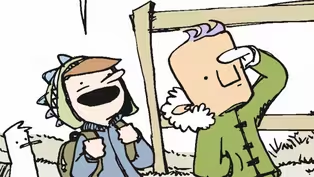
Green Seeker: Catch and Release
Clip: Season 4 Episode 23 | 6m 14sVideo has Closed Captions
A Salve Regina University professor catches birds in the name of science.
A bird in the hand is worth two in the bush. That’s especially true for Jameson “Jim” Chace, a professor at Salve Regina University who catches birds in the name of science.
Problems playing video? | Closed Captioning Feedback
Problems playing video? | Closed Captioning Feedback
Rhode Island PBS Weekly is a local public television program presented by Ocean State Media

Green Seeker: Catch and Release
Clip: Season 4 Episode 23 | 6m 14sVideo has Closed Captions
A bird in the hand is worth two in the bush. That’s especially true for Jameson “Jim” Chace, a professor at Salve Regina University who catches birds in the name of science.
Problems playing video? | Closed Captioning Feedback
How to Watch Rhode Island PBS Weekly
Rhode Island PBS Weekly is available to stream on pbs.org and the free PBS App, available on iPhone, Apple TV, Android TV, Android smartphones, Amazon Fire TV, Amazon Fire Tablet, Roku, Samsung Smart TV, and Vizio.
Providing Support for PBS.org
Learn Moreabout PBS online sponsorship- This bird is actually fairly fat, so it's doing pretty well.
My name is Jim Chase.
I'm a professor at Salve Regina University here in Newport, Rhode Island.
(bird squawks) And what I've been doing over the course of my career, over 20 years, is banding birds as a way to look at populations and how populations change over time.
(gentle music continues) The first instance of bird banding in this country was John James Audubon, who captured a phoebe on its nest and with his bare hands, 'cause they're close sitters, and he tied a little string around its leg.
And lo and behold, that bird came back to the same nest the next year.
And in a sense, that's what bird banding is.
You're banding birds in a particular location, and you're most likely to find those birds if they survive in that location the next year.
So we're gonna go check the nets.
I've got one net here and then four others.
The night before, I put the mist nets up in locations where I think the birds are gonna fly.
And I put these in the same place each week.
And then right before dawn I open the net up, and these are such fine nets, the birds really can't see them.
And they've been flying back and forth through these little corridors.
There's been nothing in their path.
They don't even think about it.
It'd be like if someone put a net in your doorway.
Oh, here we got a bird here.
So the bird just sort of gets caught like it's almost in a hammock as it flies straight in, and it doesn't get injured, 'cause it sort of sits there calmly, usually.
I check pretty often, so no bird is hanging for too long.
Just a matter of very gently backing them out of the net they just flew into.
And there's a song sparrow, another juvenile song sparrow.
(gentle music) I put it into a little bag, and that holds the bird securely until I can process it back at the banding station.
I bring it back to a central banding station where I have all my tools, and it's in a safe place away from distractions or where the bird could get injured.
This is one of the birds, the Carolina wren, that has been expanding its range north, presumably with climate change as a part of it.
You wouldn't have found it on this island or in Rhode Island really 30 years ago, and here they are breeding and successfully breeding.
We've got these Fish and Wildlife Service bands.
Each are uniquely marked, so that each bird has its own unique number.
Unfortunately, the bird hit a window or died, and someone found it and they reported the band number.
We would know, I would know where it came from here and where it went, and the person who found it would know where it was last banded.
So those little bits of information are just critical.
(bird squawking) A recent study by the Cornell Lab of Ornithology, which came out about two years ago, showed through a variety of different levels of evidence that songbirds, well birds in general, but songbirds especially, are in significant decline since 1970, about 30% fewer birds.
So when you think about that, 30% fewer birds, if you're sitting here, and you're listening to the birds singing, if you were here in 1970, there'd be 30% more birds singing.
It's billions of birds lost.
And we have lots of ideas as to why those birds are being lost.
(gentle music) So when the Carolina wren begins to show up in Rhode Island several years ago, that's a signal that climate change is having an effect, and birds are beginning to move and change their ranges.
So this is the American gold finch.
They're just a brilliantly patterned bird (finch chirping) and feisty.
One of the first things I measure very quickly is the wing cord, which gives an idea of body size, 'cause birds have different body sizes, and their body size to weight ratio is an important index of their health.
The last thing I measure is their mass, because that's the place where the bird's most likely to escape.
Now we'll get a weight and then let this guy go.
In between those times, I'm looking at measures of the bird's age and sex.
If it's a female in the summer, I can tell you if she's sitting on eggs now or her eggs have basically, she's done sitting on eggs, and she probably has young out of the nest.
So I blow on the bird's belly.
What they get is they'll get a brood patch.
They'll lose the feathers across their breast, and that's what they can sit on the eggs with.
Birds hold a special fascination for me, because they're colorful, they're out during the daytime, they sing, you can identify them by their songs and their calls.
And then the birds become like the classic canary in a coal mine, they become a bellwhether for the environment, so they can tell us a lot about what's going on, even before we notice that there's environmental changes happening, the birds begin to tell us.
(bright music) - That's our broadcast this evening.
Thank you for joining us.
Video has Closed Captions
Clip: S4 Ep23 | 10m 24s | An emergency room doctor recounts his experience on COVID-19’s frontlines. (10m 24s)
Video has Closed Captions
Clip: S4 Ep23 | 10m 32s | David Wright profiles the creator of the nationally syndicated cartoon Wallace the Brave. (10m 32s)
Providing Support for PBS.org
Learn Moreabout PBS online sponsorship
- News and Public Affairs

Top journalists deliver compelling original analysis of the hour's headlines.

- News and Public Affairs

FRONTLINE is investigative journalism that questions, explains and changes our world.












Support for PBS provided by:
Rhode Island PBS Weekly is a local public television program presented by Ocean State Media

